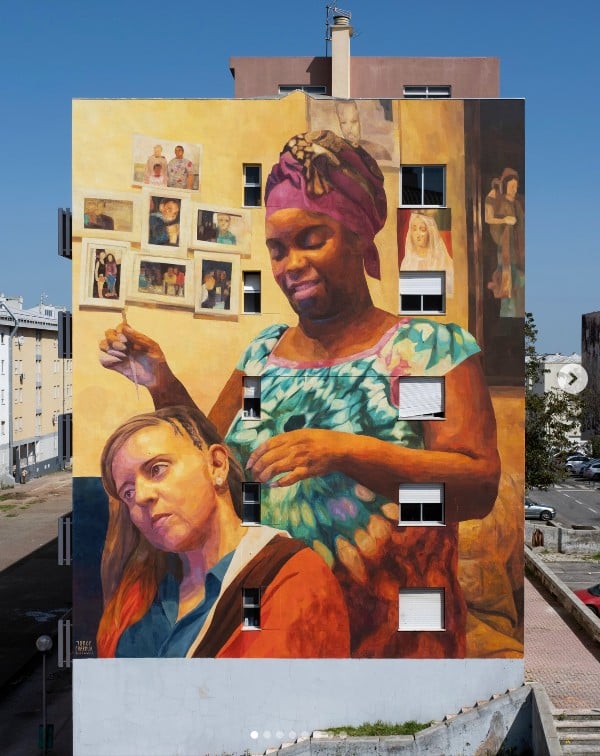SDG 1 – Eradicate Poverty – portrayed by the hand of artist Jorge Charrua
UNRIC: Ten murals have already been completed. In most cases, the community is involved in the artistic work. Can you give some examples of how this was done?
Mário Linhares: In SDG 1 – Eradicate Poverty, for example, we wanted to start with real stories of people who turned things around concerning poverty. The painting we have tells the story of two unlikely sisters who grew up together. This is because a family in the neighbourhood adopted one of them. One is white, and the other – is Cape Verdean[AV1]; it is a compelling story, as it also shows how racism makes no sense. Because she belonged to an extended family, she had access to experiences and opportunities she would not have had with her biological family alone. It’s a very inspiring story!
In fact, the neighbourhood is full of stories of families and people who turned things around, which is incredible to see. Sometimes, you must be in contexts like these to realize that overcoming is always possible, even in difficult situations. When we can’t do it alone, the community we are part of can and should help.
But this project is more than just artistic. It intends to be the starting point for initiatives that have a social impact on the neighbourhood.
This mural illustrates SDG 5 – Gender Equality – by Mariana Duarte Santos
Check the making-off of the mural on the SDG 5 – Gender Equality.
UNRIC: Can you explain how it will be done?
Mário Linhares: When someone hears about Zambujal 360, they might think it’s just another urban art project, but when they visit us, they quickly realize that our urban art gallery on the SDGs means much more. For example, on SDG 5 – Gender Equality, is represented by a game of chess. In this intellectual game, men and women compete equally, regardless of their physical strength.
We want to call chess associations to the neighbourhood and encourage children to play chess. Moreover, this wall portrays many books by different authors that directly or indirectly address the topic of gender equality. This way, we also want to promote reading and dialogue so that people become restless and want to read some of these authors.
The main idea is that each painting and its respective SDG are a match that initiates and leads to transformation. It may be more personal, internal, or within the community, but we are creating conditions for something different.
In addition, some partners want to contribute beyond what we imagined. For example, the EDP (Portuguese Electricity Company) intends to install renewable energy panels to make buildings more energy efficient, bringing its know-how related to SDG 7. The Portuguese Mint Office wants to publish a book with all the stories of the paintings. The Luso-American Development Foundation (FLAD) promotes the project to North American university students studying in Portugal. The Altice Foundation also supports us with technology and communications. Vieira de Almeida gives us legal support. These are just a few examples of how partnerships can always be more than just the initial sketch.
The artist Lígia Fernandes was inspired by the neighborhood’s vegetable gardens to create the mural about SDG 2 – Zero Hunger.
UNRIC: When are all the murals expected to be completed? The idea is to have an SDG route that attracts tourists and visitors and brings more people to the neighbourhood…
Mário Linhares: I’ve decided to ask Chat-GPT where one should go to learn more about the SDGs. The first answer it gives is to go to the United Nations headquarters in New York. There are no other specialized places on the topic.
In Portugal, the Zambujal neighbourhood is already a place to visit to learn more about the 17 SDGs. Teachers and students of any academic cycle or degree are welcome, as are companies, associations, family members, and tourists. To visit us, you need to buy a ticket for a guided tour, which allows you to learn about the history of the neighbourhood, the paintings, and their relationship with the SDGs.
The training we are providing to young people will allow them to become SDG ambassadors. As it is a paid guided tour, each young person will be paid for their work. This is our sustainability model; in addition to guaranteeing the project’s economic autonomy, it enables decent work for young people.
But not to avoid the question, we hope to have the SDG urban art gallery ready by the end of 2024. One of the murals will be ceramic! This way, we will honour Portugal’s long historical tradition in urban art through clay modelling and tiles.
In Portugal, a place not on the map before will become a source of interest and debate: the Zambujal neighbourhood, the first social neighbourhood ambassador of the 17 SDGs.
Find out more about Zambujal 360.
Source link : https://unric.org/en/zambujal-360-an-innovative-project-on-the-sdgs-in-portugal/
Author :
Publish date : 2024-06-24 07:00:00
Copyright for syndicated content belongs to the linked Source.
